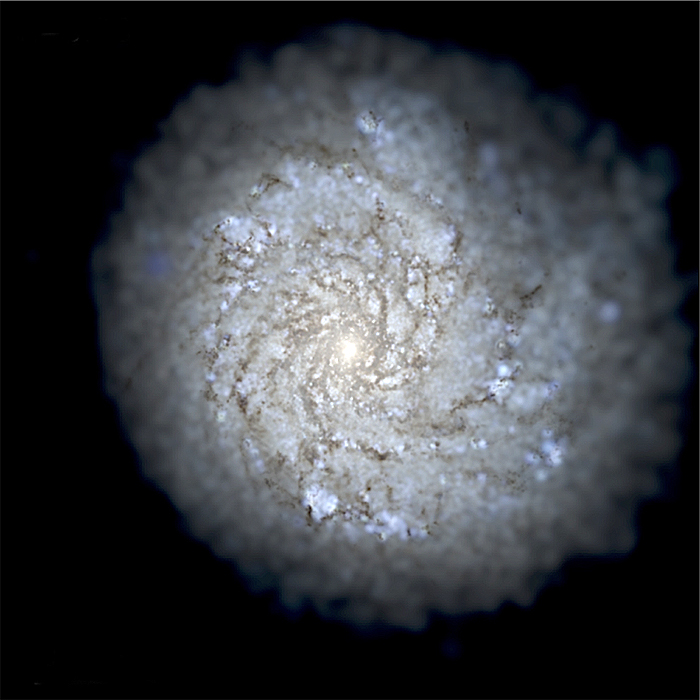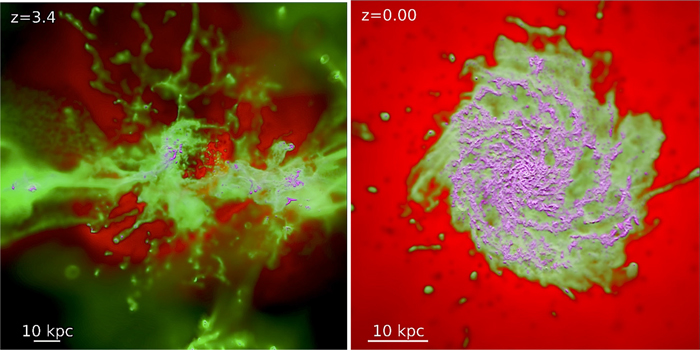.

Spiral structure emerges in Feedback in Realistic Environments (FIRE) simulation, which modeled stellar feedback on galaxy formation.
.
An interstellar mystery of why stars form has been solved thanks to the most realistic supercomputer simulations of galaxies yet made.
Theoretical astrophysicist Philip Hopkins of the California Institute of Technology (CalTech) led research that found that stellar activity — like supernova explosions or even just starlight — plays a big part in the formation of other stars and the growth of galaxies.
"The Stampede supercomputer at TACC was the workhorse of these simulations."
Philip Hopkins, assistant professor of theoretical astrophysics, California Institute of Technology.
"Feedback from stars, the collective effects from supernovae, radiation, heating, pushing on gas, and stellar winds can regulate the growth of galaxies and explain why galaxies have turned so little of the available supply of gas that they have into stars," Hopkins said.
Galaxy simulations were tested on the Stampede supercomputer of the Texas Advanced Computing Center (TACC), an Extreme Science and Engineering Discovery Environment-allocated (XSEDE) resource funded by the National Science Foundation.
The initial results were published September of 2014 in the Monthly Notices of the Royal Astronomical Society. Hopkins's work was funded by the National Science Foundation, the Gordon and Betty Moore Foundation, and a NASA Einstein Postdoctoral Fellowship.
The mystery begins in interstellar space, the vast space between stars. There dwell enormous clouds of molecules, mainly hydrogen, with the mass of thousands or even millions of Suns. These molecular gas clouds condense and give birth to stars.
What's puzzled astrophysicists since the 1970s is their observations that only a small fraction of matter in the clouds becomes a star. The best computer simulations, however, predicted nearly all of a cloud's matter would cool and become a star.
"That's really what we were trying to figure out and address, for the first time, by putting in the real physics of what we know stars do to the gas around them," Hopkins said.
.

Two stills of galactic gas from the Feedback in Realistic Environments (FIRE) simulation. Represented here is a Milky Way mass halo, with colors denoting different densities. Magenta shows cold molecular/atomic gas (T < 1000 K). Green shows warm ionized gas (10e4 < T < 10e5 K). Red shows hot gas (T > 10e6 K). Left box is at high redshift, and the right is at present day. A more relaxed, well-ordered disc has formed, with molecular gas tracing spiral structure, and a halo enriched by diffuse hot outflows.
.
A multi-institution collaboration formed with members from CalTech, U.C. Berkeley, U.C. San Diego, U.C. Irvine, Northwestern, and the University of Toronto. They produced a new set of supercomputer galaxy models called FIRE or Feedback in Realistic Environments. It focused the computing power on small scales of just a few light years across.
"We started by simulating just single stars in little patches of the galaxy, where we trace every single explosion," Hopkins explained. "That lets you build a model that you can put into a simulation of a whole galaxy at a time. And then you build that up into simulations of a chunk of the universe at a time."
.

Feedback in Realistic Environments (FIRE) simulation in visible light of a galaxy forming. Click here for the full movie. The animation starts when the Universe was just a few million years old (redshift of 100) and evolves billions of years to the present day (redshift of 0). Blue regions are young star clusters that have blown off the gas and dust from which they formed. Red regions are obscured by large amounts of dust.
.
Hopkins developed the simulation code locally on a cluster at CalTech, but the Stampede supercomputer did the lion's share of the computation.
"Almost all of these simulations were run on XSEDE resources," Hopkins said. "In particular the Stampede supercomputer at TACC was the workhorse of these simulations…Stampede was an ideal machine — it was fast, it had large shared memory nodes with a lot of processors per node and good memory per processor. And that let us run this on a much faster timescale than we had originally anticipated. Combined with improvements we made to the parallelization of the problem, we were able to run this problem on thousands of CPUs at a time, which is record-breaking for this type of problem," Hopkins said.
The realism achieved by the FIRE galaxy simulations surprised Hopkins. Past work with sub-grid models of how supernovae explode and how radiation interacts with gas required manually tweaking the model after each run.
"My real jaw-dropping moment," Hopkins said, "was when we put the physics that we thought had been missing from the previous models in without giving ourselves a bunch of nobs to turn. We ran it and it actually looked like a real galaxy. And it only had a few percent of material that turned into stars, instead of all of it, as in the past."
FIRE has mostly simulated the more typical and small galaxies, and Hopkins wants to build on its success. "We want to explore the odd balls, the galaxies that we see that are of strange sizes or masses or have unusual properties in some other way," Hopkins said.
Hopkins also wants to model galaxies with supermassive black holes at the center, like our own Milky Way. "In the process of falling in, before matter actually gets trapped by the black hole and nothing can escape, it turns out that for the most massive galaxies, this is even more energy than released by all the stars in the galaxy. It's almost certainly important. But it's at the edge, and we're just starting to think about simulating those giant galaxies," Hopkins said.
Quelle: TACC
4528 Views
